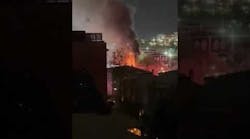This search line survival course was developed using an acquired structure and minimal building supplies. Various obstacles were created by simply cutting holes in walls, removing various sections of floor materials, and constructing minimal props such as the collapse simulators, debris piles, door enclosures and entanglement hazards. To ensure that each participant goes through all of the pre-established obstacles, the search line was attached to the floor surface using quick release clips, which were purchased at the local hardware store.
SAFETY NOTICE: Prior to conducting this training program, an instructors meeting should be conducted with a detailed safety briefing to insure that proper supervision is provided for each participant and that potential hazards are identified and addressed accordingly throughout the course.
SAMPLE COURSE INSTRUCTIONS/OVERVIEW:
2. Search crew participants shall work in teams of no less than (2) two and no more than (3) three.
3. Each search group shall be equipped with (2) two hand tools, preferably (1) Halligan, and (1) axe, closet hook or short pike pole.
4. Each search group shall be equipped with at least one (1) radio.
5. Participants shall follow the search line (in descending order - i.e. start at Knot No. 9 and proceed to Knot No. 1. This simulates an EXIT Drill thus justifying the instructions to continue past the identified hazards.) until they can go no further or until they reach the exit point. It is important to note, some participants may not complete the course in it's entirety, instructors must be prepared to provide immediate relief/rehab to those participants who stop throughout the course. SAFETY NOTE: Do NOT force a participant to go beyond his/her personal limitations.
6. Group leaders shall be required to give progress reports (Progress reports shall consist of: C - Conditions, A - Actions, N - Needs), hazard assessments, and personnel accountability reports (PAR) throughout the training session.
7. The Incident Commander shall request for a PAR/Role Call every 12-15 minutes. The use of shorter duration PAR checks during this training program has proven to be beneficial in the fact that participants get use to frequent PAR/Role Call checks and become less frustrated on the fireground where they experience longer durations between PAR/Role Call checks.
8. Search crewmembers shall immediately request "Emergency Traffic" when their low-pressure alarm activates. Once "Emergency Traffic" is requested and confirmed by command, he/she shall provide an immediate C.A.N. report (C-Conditions, A-Actions, N-Needs - i.e. "RIT Team 2 to Command, we are low on air, we're attempting to reach Knot No. 2, we need two (2) SCBA's set up at Knot No. 2."). Upon receiving this information, the Incident Commander shall transmit this request (via radio) to the logistical support personnel (One inside instructor shall serve as the "Logistics Officer" and direct inside operations accordingly.) inside the structure. Upon receiving this request, the instructor serving as "Logistics" shall confirm this request and complete the task as directed.
Note: To enhance the IMS functions of this drill, consider requiring the Incident Commander to assign an Air Supply Officer who is strictly responsible for providing the correct number of cylinders to "Logistics" upon request. This remote activity not only lessons the down time for outside personnel, it also requires the acting Incident Commander to manage his/her resources more effectively while at the same time he/she must communicate specific instructions in order for the prescribed task to be completed.Upon reaching the knot with the requested SCBA's, the search crew will then doff their expired packs and don the fresh packs, which have been provided. The key is to keep the crew moving throughout the course and to reduce there down time during SCBA change outs.
CAUTION: This is not intended to be a recommended practice during low air supply situations, rather a means of quickly replenishing the participants air supply so he/she can continue with the drill.
9. As search crewmembers encounter identifiable hazards, the group leader shall be required to notify command of their approximate location (based on the knot system) and the hazard they have encountered (Again, the crew leader should use the C.A.N. acronym when providing progress reports and conclude his/her report with a PAR count). The incident commander shall document this information and properly track the crews progress accordingly via the tracking/accountability system being used
10. The incident commander shall be responsible for tracking the crew's progress within the structure, individual entry times, exit times, personnel accountability reports and overall resource management. As an added benefit, logistical support personnel should be encouraged to occasionally contact command and request specific information such as; location of RIT Team 4. By doing this, we can determine the accuracy of our accountability system and the effectiveness of the operating Incident Commander. This should not be used as a means of embarrassing the participants, but rather as a learning tool.
In part III of this series we will incorporate basic and advance obstacles to be incorporated into the Search Line Survival Training Course.
Related:








